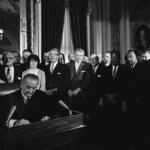Supplement your students’ understanding of voting rights in the United States with this free downloadable timeline. This visual guide breaks down the history of voting rights across identities, and gives context to efforts to expand and limit voting access over time, through the lenses of our three branches of government and our federal system.
Should the Voting Age Be Lowered to 16?
Using this resource, students will view short C-SPAN video clips exploring the background and different arguments surrounding the question over the current voting age. This deliberation has students learn about the history of lowering the voting age and explore the question: Should the voting age be lowered to 16?
Expansion of Voting Rights
This lesson provides students with a brief overview of the historical evolution and expansion of voting rights in the United States. Students will discuss examples of previous “voting qualifications” used by states in the past to deny minorities the right to vote. They will reflect on why the right to vote is important, and appreciate the outcomes of constitutional amendments, Supreme Court decisions, and the Voting Rights Act in the expansion of this right.
How the Law Regulates Who Votes

In this lesson, students will discuss what qualifications are necessary to vote. The activity presents a series of potential voters for a student council election, and asks that students either allow or prohibit each person from voting. After reflecting on their justifications, they will learn that states and the federal government have very few restrictions on voting. The instructor might then lead a discussion on the importance of voting to the democratic process
Voting Rights Act of 1965: Lesson Plans & Resources

On August 6, 1965, President Lyndon B. Johnson signed the Voting Rights Act into law. This landmark piece of legislation made discrimination based on race illegal. This law protected the right to vote for all citizens; forced states to obey the Constitution; and reinforced the 15th Amendment. The Share My Lesson team has curated a collection of free lesson plans, activities, and classroom materials that educators can use to teach students about the Voting Rights Act.
Evaluating the New Departure Strategy in the Fight for Women’s Suffrage
In this activity, students will evaluate the New Departure strategy of the women’s suffrage movement – the idea that the Constitution already guaranteed the right to vote for women, they just had to test it by voting – that was championed by the National Woman Suffrage Association. Students will analyze documents from Susan B. Anthony’s arrest and trial for voting in the 1872 election. They will answer questions as they work through the documents and evaluate the claim that the Fourteenth Amendment enfranchised women.
Bell Ringer: Ranked Choice Voting
This bell ringer explores ranked choice voting and how it can be used as a tool to reduce political polarization.
Voting Rights
The right of a citizen to vote is not directly protected in the Constitution, and throughout our history that right has often been granted to some, but denied to others. However, through various amendments to the Constitution, the right to vote has become more and more inclusive. Uncover the battle for voting rights in the National Constitution Center’s learning module.
Deliberation Materials: Should Voting Be Compulsory in the United States? (Middle School)
Should voting be compulsory in the United States? This activity includes a deliberation reading and glossary, as well as accompanying handouts to give students additional information on the topic and to guide them through the deliberation process from planning to reflection. Deliberation teaches people how to discuss controversial issues by carefully considering multiple perspectives and searching for consensus. In preparation for deliberations, all participants read common, balanced background information on the issue. During the discourse, they offer arguments for each position on a contested public issue, first drawing from the text and then bringing in their own experiences.
Voting: What Is It And Does It Matter?
This short activity is designed to introduce students to the concept of voting and its importance to American citizenship. Materials are also available in Spanish. Free registration is required to access the lesson plan.